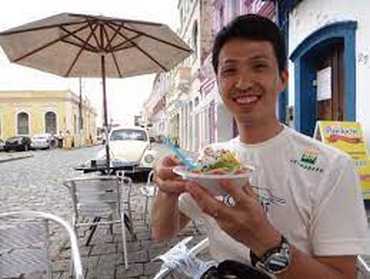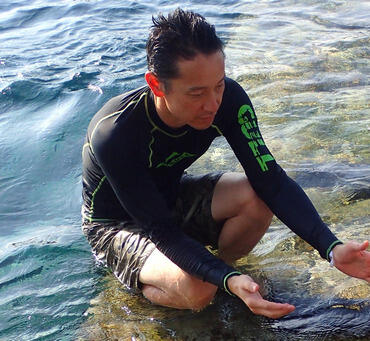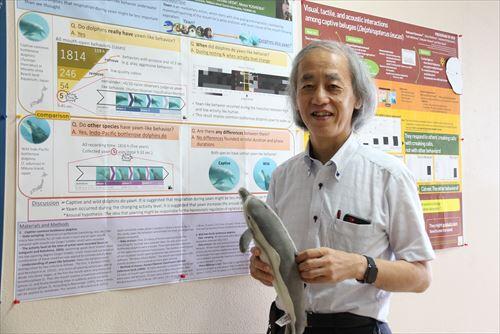Summary of our research
If we understand how an animal maintains relationships among individuals and the type of society it has, we can not only gain a deeper understanding of the animal's ecology but also reveal the evolutionary pathway that led to our complex human society. Free-ranging Indo-Pacific bottlenose dolphins off Mikura Island, one of the islands in the Izu archipelago of Tokyo, have been studied for 28 years. Through individual identification studies, almost all individuals (approximately 140) have been identified and named. As a result, this population is an ideal candidate for studying animal society. To study dolphin society, there is a method that considers the individuals within a group to have strong relationships with each other. Indo-Pacific bottlenose dolphins, however, have a society characterized by high fission-fusion dynamics, where group membership easily changes over time. This makes it difficult to define a clear "group" definition for these dolphins. Also, we have not yet established a clear group definition for underwater observation of the dolphins off Mikura Island, despite accumulating extensive underwater video footage. Therefore, we decided to make an appropriate group definition for underwater observations by comparing simultaneous observations of dolphins from both a boat and underwater.
We first observed a group from a boat with the group definition for boat observations: 'Individuals in spatial proximity move in a similar direction and usually engage in similar activities'. Underwater observers simultaneously video-recorded dolphins in the target group from underwater. We stopped both types of observations if the dolphins left our boat, and searched for another or the same group. We repeated these observations several times during a trip. After returning to our lab, we defined groups using five candidate methods for underwater group definition from the video recordings. We then checked whether successive two groups were the same or different (for example, whether a group observed at 10:20 was the same as or different from a group observed next at 10:45). We determined the underwater group definition that returned the most similar results to the boat observations by comparing the results of the boat and underwater observations (Fig). The "E+ID method" ※1 returned the most similar results and social indices to the boat observation both in 2018 and 2000, with 234 underwater observations, suggesting this method is the best.
This underwater group definition enables us to reveal the social relationships or "good relationships" of Indo-Pacific bottlenose dolphins by using underwater video accumulated over many years at this site. Social relationships of Indo-Pacific bottlenose dolphins become one of the important pieces of information to answer how sociality has evolved in toothed whales (odontocetes), and why such sociality evolved.
And it is expected that we will acquire clues to reveal how animal societies, including human society, have evolved.
※1 "E+ID method": "All video-recorded dolphins during one encounter (from entering to exiting the water) are defined as a group, and groups with at least one
shared individual during one survey were treated as the same group." This definition is simple enough to be applicable to other populations and/or another animals.
Fig. An example of the comparison between boat and underwater observations. Boat observation could not identify individuals, and traced the whole group movement. Underwater observation identify individuals, and defined a group using five candidate methods. In this case, the E+ID method defined a group during encounter #1 and #3 as the same because the same individual (#A) were seen in both encounters.
Researcher information

MORISAKA Tadamichi
Professor, Cetacean Research Center, Graduate School of Bioresources
Specialized area:
Bioacoustics, Ethology, Cetology
Current research field:
Description of interesting behaviors in cetaceans, Development of the elementary techniques for cetacean conservation, Basic study for cetacean communication and society

FURUICHI Tomo
Master's course, Graduate School of Bioresources (at the time of the study)
Specialized area:
Ethology (Animal behavior)
Current research field:
Conservation biology

KOGI Kazunobu
Executive Director, Mikurashima Tourism Association
Specialized area:
Conservation biology, Cetology
Current research field:
Conservation of cetacean off Mikura Island, Description of fauna in Mikura Island

YOSHIOKA Motoi
Professor, Graduate School of Bioresources (2023.5 Executive Vice President)
Specialized area:
Marine mammalogy, Reproductive physiology
Current research field:
Understanding of the mechanism of cetacean reproductive physiology・Understanding of the life history of narrow-ridged finless porpoises in Ise Bay